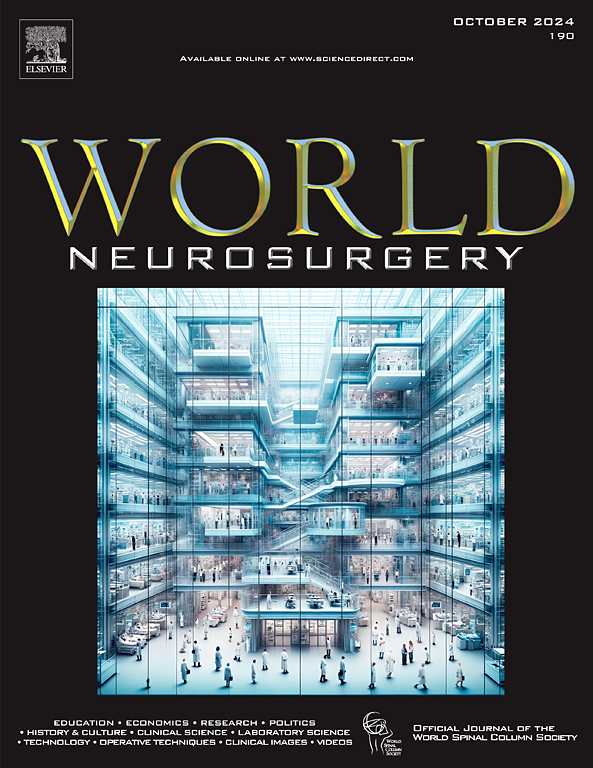体重调整腰围指数与腰痛患病率之间的关系:来自NHANES的横断面观察性研究。
IF 1.9
4区 医学
Q3 CLINICAL NEUROLOGY
引用次数: 0
摘要
体重调整腰围指数(WWI)是一种新型的肥胖指数,其计算方法为腰围(WC)除以体重(kg)的平方根。先前的研究表明,较高的身体质量指数(BMI)和腰围会增加腰痛(LBP)的风险。然而,没有研究探讨第一次世界大战与LBP之间的关系。方法:本横断面研究使用的数据来自国家健康和营养检查调查(NHANES)。采用三种logistic回归模型评价第一次世界大战与LBP之间的关系,采用分层分析评价结果的稳定性。采用受试者工作特征(ROC)曲线直观评价和比较WWI、BMI、WC和体重对LBP的预测效果。结果:WWI与LBP、模型1 (OR = 1.222, 95%CI [1.164,1.283], P < 0.0001)、模型2 (OR = 1.187, 95%CI [1.118,1.261], P < 0.0001)、模型3 (OR = 1.129, 95%CI [1.056,1.207], P < 0.001)呈正相关。与Q1相比,Q3(模型1 (OR = 1.241, 95% ci [1.114, 1.382], P < 0.001)、模型2(OR = 1.192, 95% ci [1.050, 1.353], P = 0.007)、模型3(OR = 1.145, 95% ci [1.002, 1.310], P = 0.047)、Q4(模型1 (OR = 1.524, 95% ci [1.341, 1.733], P < 0.0001)、模型2(OR = 1.422, 95% ci [1.233, 1.640], P < 0.0001)、模型3(OR = 1.333, 95% ci [1.149, 1.547], P < 0.001)之间均呈显著正相关。WWI的AUC为0.5447536,BMI的AUC为0.5466724,WC和weight的AUC分别为0.5501341和0.5376615。结论:本横断面研究显示WWI与LBP之间存在显著正相关,但WWI的预测效果并不优于BMI和WC。本文章由计算机程序翻译,如有差异,请以英文原文为准。
Association Between Weight-Adjusted Waist Index and the Prevalence of Low Back Pain: A Cross-Sectional Observational Study from National Health and Nutrition Examination Survey
Background
The weight-adjusted waist index (WWI) is a novel obesity index that is calculated as the waist circumference (WC) divided by the square root of body weight (kg). Previous studies have revealed that higher body mass index (BMI) and WC increase the risk of low back pain (LBP). However, no research explores the relationship between WWI and LBP.
Methods
Data utilized in this cross-sectional study were drawn from the National Health and Nutrition Examination Survey. Three logistic regression models were used to evaluate the association between WWI and LBP. Stratified analysis was applied to assess the stability of the results. Receiver-operating characteristic (ROC) curves were employed to visually assess and compare the predictive effectiveness of WWI, BMI, WC, and weight on LBP.
Results
A significant positive correlation was observed between WWI and LBP, model 1 (odds ratio [OR] = 1.222, 95% confidence interval (95% CI) [1.164, 1.283], P < 0.0001), model 2 (OR = 1.187, 95% CI [1.118, 1.261], P < 0.0001), and model 3 (OR = 1.129, 95% CI [1.056, 1.207], P < 0.001). Relative to the Q1, Q3 (model 1 (OR = 1.241, 95% CI [1.114, 1.382], P < 0.001), model 2 (OR = 1.192, 95% CI [1.050, 1.353], P = 0.007), model 3 (OR = 1.145, 95% CI [1.002, 1.310], P = 0.047)) and Q4 (model 1 (OR = 1.524, 95% CI [1.341, 1.733], P < 0.0001), model 2 (OR = 1.422, 95% CI [1.233, 1.640], P < 0.0001), model 3 (OR = 1.333, 95% CI [1.149, 1.547], P < 0.001)) all showed a significant positive correlation between them. The area under the receiver-operating characteristic curve (AUC) for WWI is 0.5447536, the AUC for BMI is 0.5466724, and the AUC for WC and weight is 0.5501341 and 0.5376615, respectively.
Conclusions
This cross-sectional study revealed a significant positive association between WWI and LBP, but WWI did not show better predictive efficacy than BMI and WC.
求助全文
通过发布文献求助,成功后即可免费获取论文全文。
去求助
来源期刊

World neurosurgery
CLINICAL NEUROLOGY-SURGERY
CiteScore
3.90
自引率
15.00%
发文量
1765
审稿时长
47 days
期刊介绍:
World Neurosurgery has an open access mirror journal World Neurosurgery: X, sharing the same aims and scope, editorial team, submission system and rigorous peer review.
The journal''s mission is to:
-To provide a first-class international forum and a 2-way conduit for dialogue that is relevant to neurosurgeons and providers who care for neurosurgery patients. The categories of the exchanged information include clinical and basic science, as well as global information that provide social, political, educational, economic, cultural or societal insights and knowledge that are of significance and relevance to worldwide neurosurgery patient care.
-To act as a primary intellectual catalyst for the stimulation of creativity, the creation of new knowledge, and the enhancement of quality neurosurgical care worldwide.
-To provide a forum for communication that enriches the lives of all neurosurgeons and their colleagues; and, in so doing, enriches the lives of their patients.
Topics to be addressed in World Neurosurgery include: EDUCATION, ECONOMICS, RESEARCH, POLITICS, HISTORY, CULTURE, CLINICAL SCIENCE, LABORATORY SCIENCE, TECHNOLOGY, OPERATIVE TECHNIQUES, CLINICAL IMAGES, VIDEOS
 求助内容:
求助内容: 应助结果提醒方式:
应助结果提醒方式:


